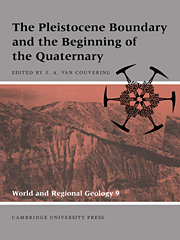Book contents
- Frontmatter
- Contents
- List of contributors
- Preface: the new Pleistocene
- Foreword
- Part I Definition of the base of the Quaternary
- Part II Characterization of the Pleistocene boundary-stratotype
- Part III The paleontological context of the Pleistocene boundary
- Part IV The Pleistocene boundary in regional sequences
- 11 The Pliocene–Pleistocene boundary in Italy
- 12 Stratigraphy of the Plio–Pleistocene sequence of the Mediterranean coastal belt of Israel and its implications for the evolution of the Nile Cone
- 13 The Pliocene–Pleistocene transition in the Iberian Peninsula
- 14 Biostratigraphy and calibrated climatic chronology of the Upper Pliocene and Lower Pleistocene of France
- 15 The Plio–Pleistocene of England and Iceland
- 16 The Neogene–Ouaternary boundary in The Netherlands
- 17 The Tertiary–Quaternary boundary in western Germany
- 18 The Pliocene–Pleistocene boundary in eastern Germany
- 19 The Plio–Pleistocene of Hungary
- 20 The Pliocene–Pleistocene boundary in Romania
- 21 The Pliocene and Pleistocene of the European part of the Commonwealth of Independent States
- 22 The N/Q boundary in Asian Russia and Tadjikistan
- 23 The Pliocene–Pleistocene boundary in the Indian subcontinent
- 24 The Pliocene–Pleistocene boundary in Japan: the Osaka Group, Kinki district
- 25 The Pliocene–Pleistocene boundary in Japan: stratigraphy in the Boso Peninsula, central Japan
- 26 The base of the Quaternary in China
- 27 Plio–Pleistocene deposits and the Quaternary boundary in sub-Saharan Africa
- 28 Plio–Pleistocene reference sections in Indonesia
- 29 The Pliocene–Pleistocene boundary in New Zealand
- 30 The Pliocene–Pleistocene boundary in continental sequences of North America
- Index
25 - The Pliocene–Pleistocene boundary in Japan: stratigraphy in the Boso Peninsula, central Japan
Published online by Cambridge University Press: 10 November 2009
- Frontmatter
- Contents
- List of contributors
- Preface: the new Pleistocene
- Foreword
- Part I Definition of the base of the Quaternary
- Part II Characterization of the Pleistocene boundary-stratotype
- Part III The paleontological context of the Pleistocene boundary
- Part IV The Pleistocene boundary in regional sequences
- 11 The Pliocene–Pleistocene boundary in Italy
- 12 Stratigraphy of the Plio–Pleistocene sequence of the Mediterranean coastal belt of Israel and its implications for the evolution of the Nile Cone
- 13 The Pliocene–Pleistocene transition in the Iberian Peninsula
- 14 Biostratigraphy and calibrated climatic chronology of the Upper Pliocene and Lower Pleistocene of France
- 15 The Plio–Pleistocene of England and Iceland
- 16 The Neogene–Ouaternary boundary in The Netherlands
- 17 The Tertiary–Quaternary boundary in western Germany
- 18 The Pliocene–Pleistocene boundary in eastern Germany
- 19 The Plio–Pleistocene of Hungary
- 20 The Pliocene–Pleistocene boundary in Romania
- 21 The Pliocene and Pleistocene of the European part of the Commonwealth of Independent States
- 22 The N/Q boundary in Asian Russia and Tadjikistan
- 23 The Pliocene–Pleistocene boundary in the Indian subcontinent
- 24 The Pliocene–Pleistocene boundary in Japan: the Osaka Group, Kinki district
- 25 The Pliocene–Pleistocene boundary in Japan: stratigraphy in the Boso Peninsula, central Japan
- 26 The base of the Quaternary in China
- 27 Plio–Pleistocene deposits and the Quaternary boundary in sub-Saharan Africa
- 28 Plio–Pleistocene reference sections in Indonesia
- 29 The Pliocene–Pleistocene boundary in New Zealand
- 30 The Pliocene–Pleistocene boundary in continental sequences of North America
- Index
Summary
Outline of geology
The Boso Peninsula is situated in the southern part of the Kanto region in central Honshu, between two major tectonic provinces of the Japanese Islands: northeastern Honshu, extending to the north, and southwestern Honshu, extending to the west. Thick marine sediments accumulated in a depositional basin that appeared in the middle Pliocene in the southern part of the Kant region; this Plio–Pleistocene section is well exposed in the Boso Peninsula.
The Tertiary and Pleistocene deposits in the Boso Peninsula consist of the Mineoka, Hota, Miura, Kazusa, and Shimosa groups, in stratigraphic order, together with younger terrace formations and volcanic-ash layers. Each of the groups is unconformable with the others. Planktonic foraminifera indicate that the Miocene–Pliocene transition is in the uppermost part of the Amatsu Formation.
After deposition of the Anno Formation of the uppermost Miura Group, the area was uplifted, and a new basin, in which the Kazusa Group was deposited, appeared to the north of the emerged area. In the central-to-eastern parts of the peninsula, the Kazusa Group comprises the Kurotaki, Katsuura, Namihana, Ohara, Kiwada, Otadai, Umegase, Kokumoto, Kakinokidai, Chonan, Mandano, and Kasamori formations, in ascending order. Those formations consist of sandstone and siltstone, with pyroclastic intercalations, and the classification of the formations is based on the predominant lithology in the interbedded rocks.
The pyroclastic intercalations of the Kazusa Group have been carefully traced in the Boso, Choshi, and Miura peninsulas, where they are used as key beds. Lateral changes in lithology and local stratigraphy have been well established (Mitsunashi and Yazaki, 1958, 1961; Mitsunashi et al., 1959, 1961, 1976a,b, 1979; Yazaki and Mitsunashi, 1962; Mitsunashi and Yazaki, 1968; Ishiwada et al., 1971).
- Type
- Chapter
- Information
- The Pleistocene Boundary and the Beginning of the Quaternary , pp. 244 - 246Publisher: Cambridge University PressPrint publication year: 1996
- 2
- Cited by



